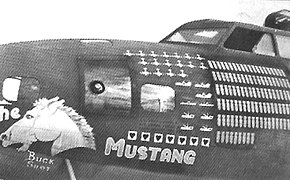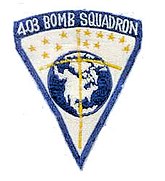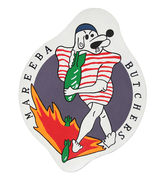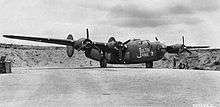403d Bombardment Squadron
The 403d Bombardment Squadron is an inactive United States Air Force unit. It was last assigned to the 43rd Bombardment Wing, based at Carswell AFB, Texas. It was inactivated on 1 January 1961.
| 403d Bombardment Squadron | |
|---|---|
 403d Squadron B-17F Flying Fortress "Mustang"[note 1] | |
| Active | 1941–1946; 1958–1960; 1960–1961 |
| Country | |
| Branch | |
| Role | Bombardment |
| Engagements | Southwest Pacific Theater[1] |
| Decorations | Distinguished Unit Citation[1] |
| Insignia | |
| Patch with 403d Bombardment Squadron emblem (approved 31 July 1959)[1] |  |
| 403dth Bombardment Squadron emblem (World War II)[2] |  |

History
World War II
Established in 1940 and activated in 1941 as a long range reconnaissance squadron, assigned to the GHQ Air Force Northeast Air District. Trained and was equipped with both early model B-17C/D Flying Fortress heavy bombers. along with and B-18 Bolo medium bombers and A-29 Hudsons at Langley Field. Primarily flew training missions over the Mid-Atlantic States. After the Pearl Harbor Attack, was deployed to New England and began flying antisubmarine missions from Bangor Airport over the Newfoundland Straits and performing aerial convoy patrols over the North Atlantic shipping lanes.
Deployed to Australia in February 1942, being assigned to the new Fifth Air Force being formed after the withdraw from the Philippines of remaining heavy bombers. The squadron reached Australia in March 1942 and was redesignated as a heavy bombardment squadron in April. Did not enter combat until September, when it finally had a reasonable complement of aircraft. From then until November 1944 the squadron operated in support of the campaign in Papua New Guinea, first from Australia, then from New Guinea and Owi Island, concentrated in particular in attacks on shipping. The unit experimented with low level skip bombing, using this tactic at the Battle of the Bismarck Sea, 2–4 March 1943 with some success.
Between May and September 1943 the squadron's B-17s were replaced with B-24 Liberators, believed to be more suited to the long ranges of many Pacific missions. In November 1944 the squadron moved to the Philippines, helping the ground campaign on Luzon as well as conducting long range strategic bombing missions against targets in China and Formosa. Finally in July 1945 it moved to Le Shima, from where it flew missions over Japan, still attacking shipping, as well as airfields and railways until the Japanese Capitulation in August. Squadron demobilized on Okinawa, aircraft being sent to the Philippines for reclamation. Inactivated as a paper unit in April 1946.
Strategic Air Command
From 1958, the Boeing B-47 Stratojet wings of Strategic Air Command (SAC) began to assume an alert posture at their home bases, reducing the amount of time spent on alert at overseas bases. The SAC alert cycle divided itself into four parts: planning, flying, alert and rest to meet General Thomas S. Power’s initial goal of maintaining one third of SAC’s planes on fifteen minute ground alert, fully fueled and ready for combat to reduce vulnerability to a Soviet missile strike.[3] To implement this new system B-47 wings reorganized from three to four squadrons.[3][4] The 403d was activated at Carswell Air Force Base as the fourth squadron of the 43d Bombardment Wing. The squadron was inactivated on 1 January 1961.
Lineage
- Constituted as the 13th Reconnaissance Squadron (Heavy) on 20 November 1940
- Activated on 15 January 1941
- Redesignated 403d Bombardment Squadron (Heavy) on 22 April 1942
- Redesignated 403d Bombardment Squadron, Heavy c. 1944
- Inactivated on 29 April 1946
- Redesignated 403d Bombardment Squadron, Medium on 20 August 1958
- Activated on 1 December 1958
- Discontinued on 15 March 1960
- Organized on 15 May 1960
- Discontinued and inactivated on 1 January 1961[1]
Assignments
- 43rd Bombardment Group, 15 January 1941 – 29 April 1946
- 43rd Bombardment Wing, 1 December 1958
- Department of the Air Force, 15 March 1960 (not organized)
- Strategic Air Command, 12 April 1960 9not organized0
- 43rd Bombardment Wing, 15 May 1960 – 1 January 1961[1]
Stations
|
|
Aircraft
- Boeing B-17 Flying Fortress, 1941, 1942–1943
- Douglas B-18 Bolo, 1941–1942
- Lockheed A-29, 1941–1942
- Consolidated B-24 Liberator, 1942–1945
- Boeing B-47 Stratojet, 1958–1960[1]
References
- Explanatory notes
- Aircraft is Boeing B-17F Flying Fortress, serial 41-24554 "Mustang". It flew with the squadron in Australia and New Guinea. It completed 109 missions and claimed 17 Japanese aircraft before being returned to the United States as "War-Weary" in late 1943.
- Aircraft is Consolidated B-24D-30-CO Liberator, serial 42-40065. Shown parked in a revetment at Dobodura Airfield on Papua,New Guinea on 11 June 1943. Tjis aircraft was lost on 9 December 1943, when it crashed into the sea after take-off for a mission.
- Citations
- Maurer, Combat Squadrons, p. 493
- Watkins, pp. 84-85
- Schake, p. 220 (note 43)
- "Abstract (Unclassified), History of the Strategic Bomber since 1945 (Top Secret, downgraded to Secret)". Air Force History Index. 1 April 1975. Retrieved 4 March 2014.
Bibliography
![]()
- Maurer, Maurer, ed. (1983) [1961]. Air Force Combat Units of World War II (PDF) (reprint ed.). Washington, DC: Office of Air Force History. ISBN 0-912799-02-1. LCCN 61060979. Retrieved 17 December 2016.
- Maurer, Maurer, ed. (1982) [1969]. Combat Squadrons of the Air Force, World War II (PDF) (reprint ed.). Washington, DC: Office of Air Force History. ISBN 0-405-12194-6. LCCN 70605402. OCLC 72556.
- Ravenstein, Charles A. (1984). Air Force Combat Wings, Lineage & Honors Histories 1947-1977 (PDF). Washington, DC: Office of Air Force History. ISBN 0-912799-12-9. Retrieved 17 December 2016.
- Schake, Col Kurt W. (1998). Strategic Frontier: American Bomber Bases Overseas, 1950-1960 (PDF). Trondheim, Norway: Norwegian University of Science and Technology. ISBN 978-8277650241. Retrieved 27 July 2015.
- Watkins, Robert A. (2013). Insignia and Aircraft Markings of the U.S. Army Air Force In World War II. Volume V, Pacific Theater of Operations. Atglen,PA: Shiffer Publishing, Ltd. ISBN 978-0-7643-4346-9.

.svg.png)